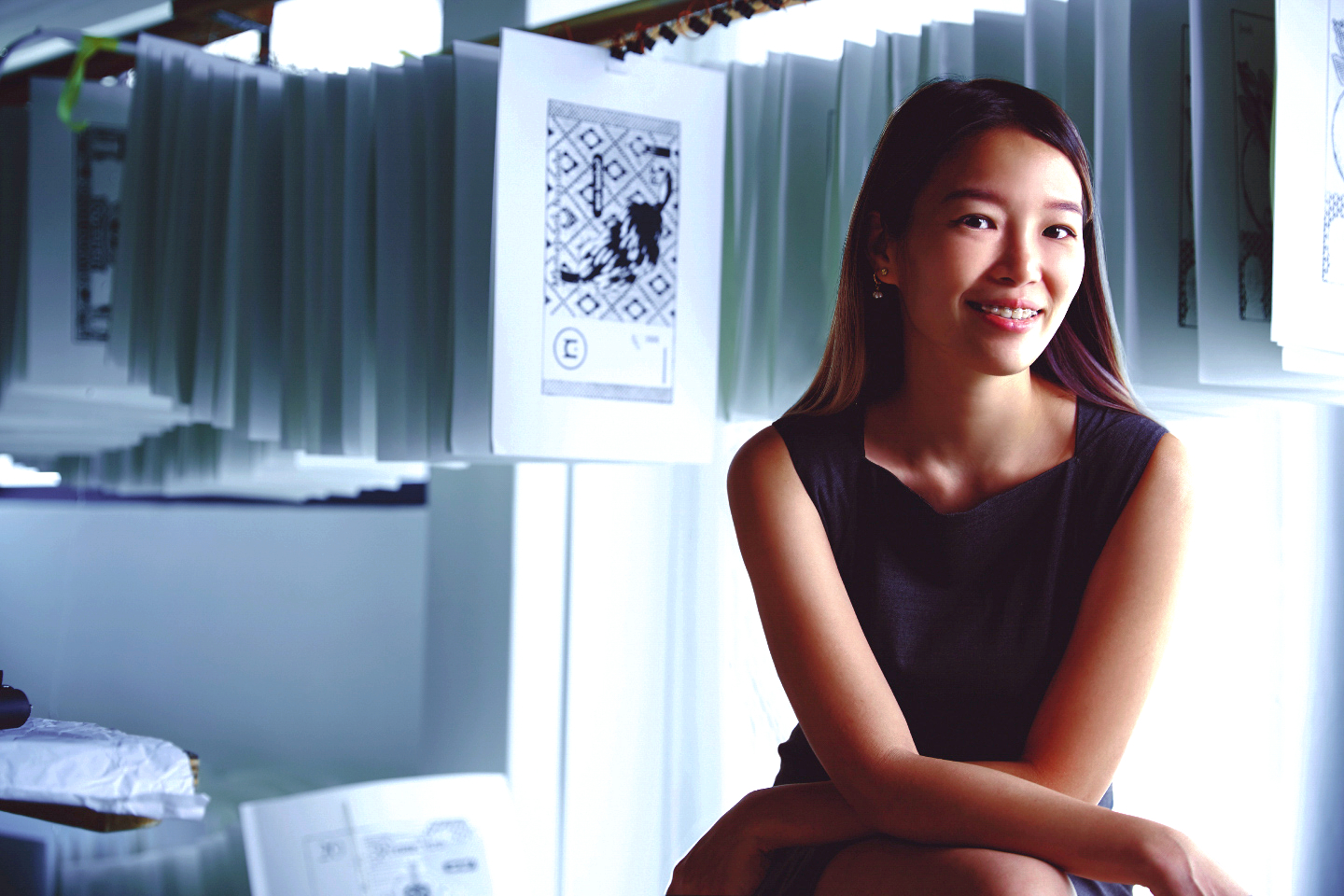
Hong Yi hopes her Memebank series will get people talking about what they may not know or think about money (Photo: Soophye)
Everyday objects and materials have a place in Red Hong Yi’s art, from basketballs and chopsticks to teabags, sunflower seeds, feathers, masks, socks, pins, flowers and matches. Now, it is banknotes printed with fun elements that she hopes will make people ask where their money comes from, who controls it, why they are supposed to save, where to put their savings and how it will grow. And, with inflation, how much is what they have put aside really worth over time?
These are questions the Sabah-born artist never asked herself until she started talking to friends about cryptocurrencies and NFTs — non-fungible tokens or digital items that can be bought and sold using blockchain technology. Piqued by the increasing value of Bitcoin and Ethereum, Hong Yi rolled up her sleeves and started creating banknotes, for a humorous take on the continual printing of fiat money, which leads to inflation.
“I want to create art that speaks about today, what’s happening right now. I knew I wanted to create NFTs. Then, I felt it would be tongue-in-cheek to print a lot of banknotes to critique what’s going on in the world — the banking system and how central banks keep printing money — and see what alternative investments the younger generations have.”
Her initial idea was to create memes. “Then I said, ‘Hold on, this is to critique, so why don’t we put memes into our banknotes’. We wanted to have a play on that.” She came up with the concept for six notes, put her team members in charge of one each and worked together with them.
_s1a9846a1.jpg
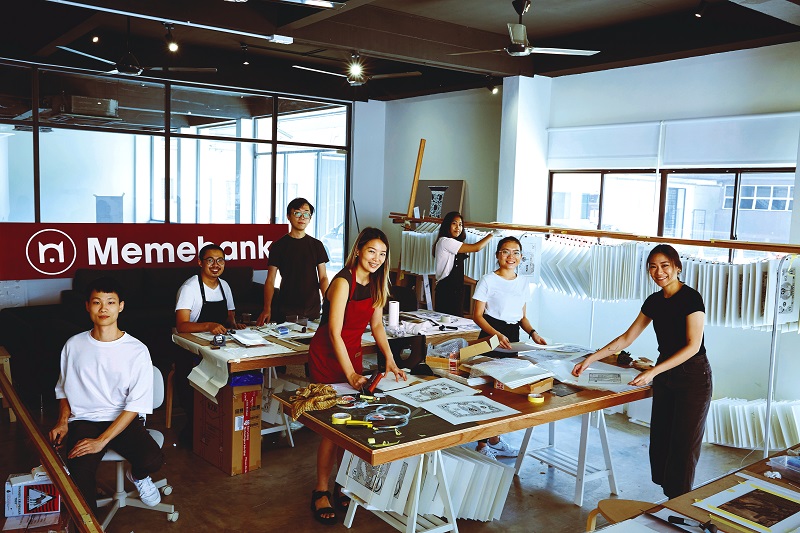
Memebank by Studio Red Hong Yi was showcased at APW Bangsar, Kuala Lumpur, from Jan 21 to 23. It featured six huge copper plates and banknotes, as well as a limited number of mini, but not complete, prints of those notes.
Designs for the pieces were inspired by currencies in circulation — the Chinese yuan, US dollar, British pound, Malaysian ringgit, Japanese yen and Singapore dollar — but the images are memes, from a dog to an orangutan, a rocket, an otter, a monkey and a comb of bananas. The last is a spoof on the banana notes rolled out during the Japanese Occupation, which were not worth the paper they were printed on after the war. “We thought the memes would be funny,” says Hong Yi.
Tracing the history of paper money, she points out that the earliest notes were found in China, printed using plates. Doge the Moon, the first piece in the Memebank series, pays tribute to that.
The team first created the banknotes digitally then etched them on copper plates. The original copper plates and printed banknotes were turned into NFTs and put up for bidding on OpenSea last year, and purchases were made in ether, the cryptocurrency. The mini prints at the exhibition, 200 for each design, are for sale and proceeds will go to Mercy Malaysia.
“The idea is that the buyers who own the big plates can print as many banknotes as they want. They are essentially the new central bank and have a say on how many notes go into circulation. If they print a lot, it will devalue the notes. If they don’t, the notes will be valuable.”
Hong Yi spent six months working on Memebank last year and hopes the series will get people talking about what they may not know or think about money, even if it does not point to any solutions. “I want to highlight issues that concern the country through art. Banking is one of them, especially how much the ringgit is worth today. The takeaway for visitors to the exhibition would be to ask why we are doing this.
_s1a9738a.jpg
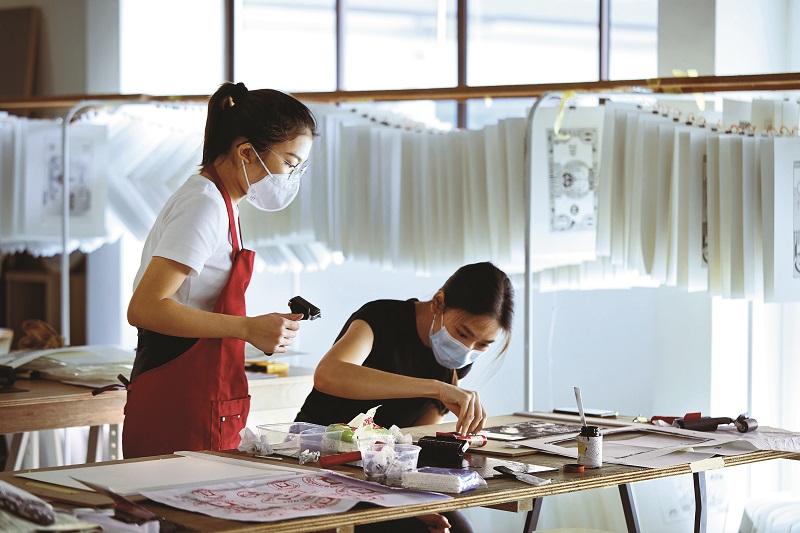
“Before, I was like, okay, put money in my account and try to save as much as possible. I never asked whether, over time, I was really saving. The show is just a parody, but I would preface it by saying I am not an economist or a finance person.”
From conversations with friends who have invested in cryptocurrencies, which “blew up” during the pandemic, she learnt that it came about because people wanted to have control over their own money, especially with fiat currencies becoming less and less valuable owing to the growing amounts in circulation. Initial bad press on Bitcoin and Ethereum made people wary. But with increasing acceptance and use in transactions, including buying art, young investors are especially drawn to them.
Reports put the cryptocurrency market size at US$1.6 billion in 2021. Economists estimate it will grow at a compound annual growth rate of 7.1% to US$2.2 billion by 2026.
Cryptocurrencies will be very ingrained in our future, says Hong Yi, who explains blockchain technology by imagining an Excel broadsheet that records everything. Transactions are recorded and cannot be deleted, like a public ledger. “If you have the younger generation adopting it now, what more in time to come as people look for alternative ways to hold their assets.
“I want to arouse questions, not so much with the Memebank images but the act of doing so many of them. When I critique something, I want to create awareness and build conversations. It’s not just about answering a question.”
Everyday concerns interest this artist, from climate change and the environment to the coronavirus, racism, abuse, misconceptions, national service and unity. What about corruption? “Yes. Memebank is about that, indirectly,” she replies with a cheeky smile.
climate_is_everything_by_annice_lyn.jpeg
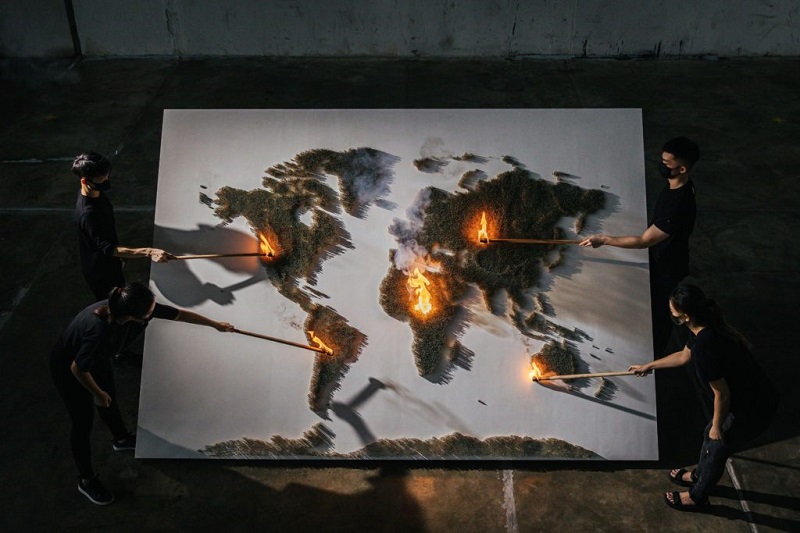
Last year, TIME magazine invited her to do a project titled Climate is Everything, to highlight that the global climate crisis will affect everyone, everywhere. She used 50,000 green-tipped matches to assemble a map of the world, then lit it up — a fiery warning of what could happen if pressing problems are not addressed fast. The image of continents aflame made the cover of the magazine’s April issue.
“That has been a highlight of my career — it was very encouraging and affirmative to be recognised. When they first called me, I was shocked. I see my favourite artists, those I respect, working with them. So, wow! It was a huge honour.”
Hong Yi burst upon the art scene in 2012 with a portrait of Chinese basketball star Yao Ming, created using red paint and a basketball. She played the sport in school and had notions of pursuing it, but eventually chose architecture because it is a mixture of art, maths and science, subjects she loved, and how architects work with different materials, measurements and dimensions.
Other unique works include an image of actor Jackie Chan using bamboo chopsticks tied in bunches, a portrait of Chinese artist cum activist Ai WeiWei made using 7kg of sunflower seeds spread on a canvas, and of director Zhang Yimou, put together using socks and pins hung from bamboo sticks, the way people hang their laundry out to dry in the old alleyways of Shanghai, where Hong Yi lived and did art on the side before her career suddenly took off.
“At the start, art was always a hobby kind of thing. I never thought it would turn into a career. It really began at the time I was in China. I wanted to highlight Chinese personalities featured in the media, like Yao Ming.
“Also, I felt there were a lot of misconceptions about the country, like life must be hard and you don’t get to be totally free. As I lived there, I began to understand a bit more, so I wanted to communicate those stories with people around the world.”
blog_img_0746.jpg
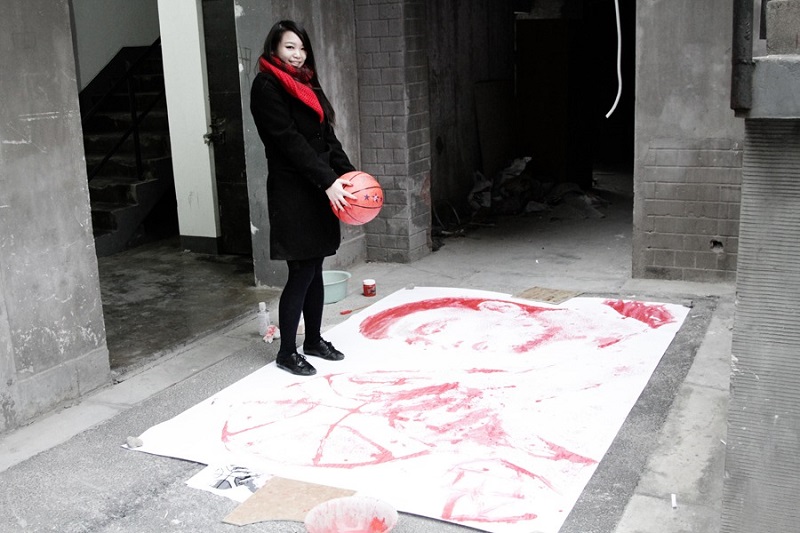
On how she chooses the medium for each work, she says, “I do a lot of research on all these personalities and the possible materials I can associate with them. If you are familiar with them, you know how they work. The hard part is using a new material because you never know how it might behave”. Such as copper, which she had never handled before.
“Suddenly I had to get ‘science-labby’ with it, and work out all these solutions [such as etching and printing]. Now, instead of jumping from one material to another, I want to try to stick to one a bit longer so I will really understand it a bit more.”
Hong Yi says she enjoyed her three years in Shanghai, her father’s birthplace. With no reference point on art and not knowing any artist — on top of having parents who kept saying, “No, don’t go into art” — she was happy to regularly meet her granduncle, a retired artist living in the city.
“I had a very romantic notion of art and would ask him, ‘You were an artist, what was it like?’ It was like my dream, right? He would say, ‘It was not that simple. At the time, you had to do what the authorities told you to, like a poster for Chinese New Year based on whatever propaganda they were trying to spread.’ During the Cultural Revolution, he was a propaganda artist — he had to be one, he had no choice.
“I was really inspired by him. I’m really interested in history and culture and learning from people who lived in the past.”
The master’s graduate in architecture from the University of Melbourne is also grateful that her boss at the architecture firm she used to work in noticed her interest in art and encouraged her to pursue it.
memebank_by_davidyeowphotography.jpg
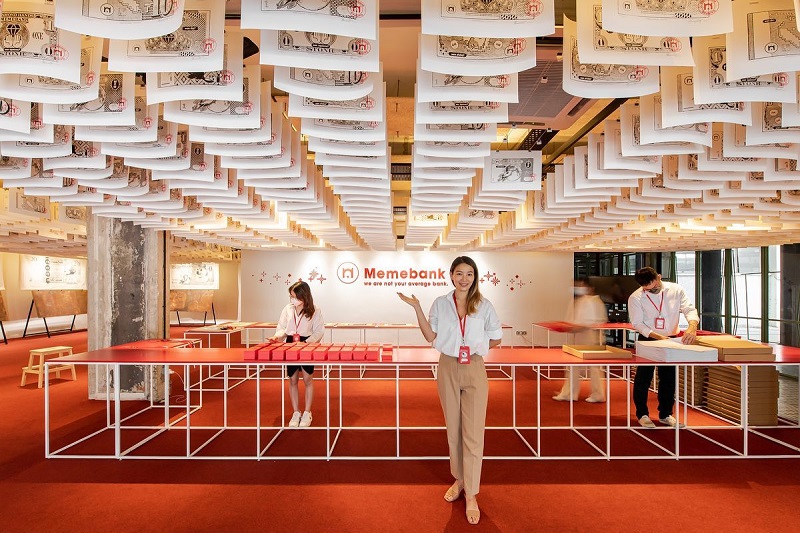
Hong Yi did, but struggled for want of direction in her early years. “I had projects coming in but didn’t know any professional artists and was lost. Many people told me all sorts of things; I wasn’t sure whose advice to heed. I wish I had more guidance then.”
After a decade of living in Australia, China and the US, she returned to her hometown just before the pandemic and is now based in KL, working from a studio the team moved into recently. With travel restrictions still rigid, she sees herself spending a lot of time in Malaysia and Singapore — with the latter “putting so much focus on its art, I want to be there a bit more”— and concentrate on what’s on her mind, like unity and womanhood. In fact, she has been working on a series of vases centred on her personal thoughts about marriage and how her career will turn out.
“I have done 10 porcelain vases focused on different issues concerning women. Despite women’s rights and all that, we still read about inequality and abuse. I want to celebrate women and talk about how far we have come and what we can do. I want to portray all that in a positive light instead of complaining about a lot of things. At the same time, there are real issues that are still happening.”
For example, women who contemplate settling down find themselves asking: What will happen after I set up home? Who will mind the children when they come? Do mothers have to give up their jobs to mind the kids?
“The series is more about personal stories, very anecdotal. There is one vase about marriage. My fiancé [Joe Lee, a cryptocurrency investor and entrepreneur, and her advisor for the Memebank project] and I talk about who will be the breadwinner between the two of us. What’s it going to look like? Do we split our assets? It has come to a point where we can talk about things on an equal footing, which I want to celebrate.”
copper_plates_at_memebank.jpg
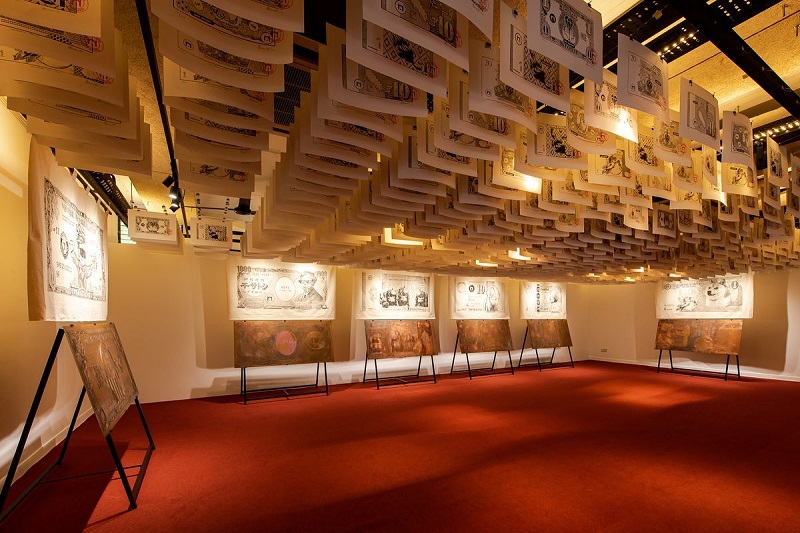
Hong Yi started working on this series in 2018 and hopes to put it up for show in August. The going has been slow because it is time-consuming and finicky work: sticking bits of eggshells on the vases, in different colours. There are elements like silhouettes that tell a story, and it is also the first time she is using eggshells.
On what new materials she may work with next, Hong Yi says she is open to what comes. If something jumps at her and triggers an idea, she is game to give it a go.
More immediately, she wants to grow her team, Artists of SEA (for Southeast Asia), which put up their first show, 1,000 Tiny Artworks by 100 Artists, at the Zhongshan Building last month, at which 602 of the pieces featured were snapped up. They hope to put up an annual exhibition every December.
Going forward, working with a team is crucial, Hong Yi says.
“When Covid-19 hit, I wasn’t sure how long my art career would go on for. Then I studied the leading artists I really admire and saw they all have a solid team behind them. When I researched the work of very successful artists, there is structure behind them. They worked with and had different teams and departments. It’s not like this perception we have of a solo artist.
“I knew I had to run my studio differently, otherwise, I would burn myself out. I wouldn’t be able to create on a certain scale any more.”
Naming the mysterious UK-based street artist Banksy as an example, she adds: “He has a huge team behind him — there’s no way he can pull off all the leading exhibitions, on that kind of scale and with that kind of marketing, by himself. From what I know, from people who worked with him, there is a streamlined process behind it. I wouldn’t be able to pull off the Memebank project without a team.”
Memebank is entirely self-funded — from purchasing the materials to doing the graphics, renting the exhibition space and taking charge of the marketing, says Hong Yi, who has exhibited at H Queens in Hong Kong, the Asian Art Museum in San Francisco, the World Economic Forum in Davos, Anchorage Museum in Alaska and JP Morgan Chase Bank in New York. She hopes to do fewer commissioned works and focus instead on her own ideas.
Besides support from her young team members, there are her parents, who have stopped freaking out. “They’re like, ‘Whatever lah, do whatever you want to do,’” laughs Hong Yi, who unwinds by rock climbing at shopping malls, chilling out at home or reading books on history and culture, “not necessarily art”.
This article first appeared on Jan 17, 2022 in The Edge Malaysia.


